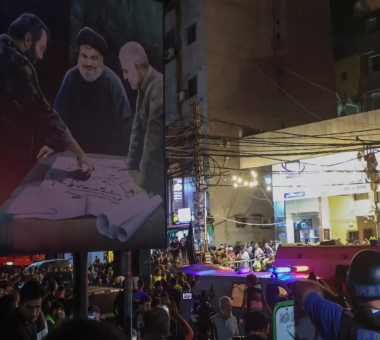Ultimate Test of Deterrence: The Israeli Assassinations of Two Axis of Resistance Leaders
The assassination of Fouad Shukr and Ismail Haniyeh put the region in extraordinary circumstances, with the Axis of Resistance acknowledging the significance of the two murders and its members threat to retaliate. Consequently, the region should expect four impending retaliatory attacks from Iran, Hezbollah, Hamas, and the Houthis.
by STRATEGIECS Team
- Release Date – Jul 31, 2024

- Editor's note: The paper was updated on August 1, 2024.
Within 24 hours, Israel carried out two assassinations of senior leaders from Hezbollah and Hamas. On July 30, 2024, the Israeli army confirmed the killing of Fouad Shukr, the head of operations for Hezbollah known as Al-Hajj Mohsen, in a bombing that targeted a building in the Dahieh suburb of Beirut. On July 31, Hamas announced the murder of its political bureau chief Ismail Haniyeh in a limited missile strike on his residence in northern Tehran.
Important Context and Critical Timing
The two assassinations coincided in timing but differ somewhat in context. The assassination of the Hezbollah leader came as part of Israel’s response to the Majdal Shams attack on July 27, which the Israeli army accused Hezbollah of carrying out. Meanwhile, the assassination of Ismail Haniyeh marks a return by Israel to its strategy of targeting Hamas leaders both inside and outside Gaza, marketing these assassinations as significant victories for the Israeli government.
Since its initial assassination of Hamas’s Deputy Political Bureau Chief Saleh Al-Arouri on January 2, 2024, Israel has been monitoring and openly discussing the movements of Hamas leaders. The choice of Tehran as the location for Haniyeh’s assassination appears to have been made to avoid the political and diplomatic fallout of killing him in Qatar, his place of residence. Additionally, Israel possesses logistical, intelligence, and operational infrastructure in Iran, as well as a high capability for access.
Regarding the method of execution, there are three possibilities. The first is that the attack was launched from Iranian territory, which is plausible considering Israel’s previous and equally complex operations inside Iran. This could have been done using a drone or, as suggested by Israeli security analyses, a Spike missile launched from a nearby location.
However, this scenario would require a complex operation to smuggle and assemble the missile inside Iran and to ensure that the Revolutionary Guard did not acquire the missile technology used. The second possibility is that the attack originated from outside Iranian borders, despite Iranian sources claiming the missile was launched from a neighboring country. As for the third possibility, according to a report published by the 'New York Times' on August 1, citing informed sources, the attack was carried out by planting an explosive device that had been smuggled a month ago into the 'guesthouse,' which is the location where he was staying during his visit to Iran.
.jpg)
A Test of Balancing Deterrence
From this point, the two operations intersect in their connection to the overall escalation between Hezbollah and Israel and its relationship with Iran, where Haniyeh was targeted. Given Tehran’s coordination in escalating its allies against Israel, the significance and status of the targeted figures in both cases reveal aspects of the relative weakness of Hezbollah and Iran in the face of clear Israeli intelligence penetration. This is alongside the assassinations carried out since the outbreak of war on October 7, 2023, that targeted leaders in Hezbollah, Iran’s Quds Force, and Hamas leaders under their protection.
All of this places Iran and its allies in a test of balancing deterrence, specifically in the choices of retaliation, which seem to be limited to a symbolic response that leaves the initiative in Israel’s hands, an equivalent response that balances the deterrence scale with Israel, or a response that returns the initiative to the axis, as happened after October 7. However, this latter option might lead to an open direct confrontation, which seems to be an unlikely option for Iran.
What Will Be the Aftermath of Assassinations
The turning point in the more dangerous Israeli escalation against the so-called “Axis of Resistance” since the outbreak of the war is not only in the status of the targets but also in the timing factor. The war in the Gaza Strip is entering a pivotal phase amid field developments and the complexities surrounding ceasefire negotiations. The intensity of confrontations between Israel and Hezbollah has been escalating since mid-June, with international warnings on the possibility of limited clashes turning into an open war. Coincidental or not, this escalation comes just days after Israeli Prime Minister Benjamin Netanyahu’s visited President Joe Biden in the United States.
In reality, the two operations place the region in exceptional circumstances, given the acknowledgment by the Axis of Resistance of the significance of the attacks and its members’ hints at retaliation. Consequently, the region is on the brink of four impending retaliatory attacks from Iran, Hezbollah, and Hamas, especially considering the Houthis’ readiness to respond to Israel’s July 20 bombing of the Yemen port city of Hodeidah.
The assassination of Haniyeh specifically calls for a response from Hamas and Iran, given where he was killed. This positions the upcoming response options along multiple scenarios.
The first scenario involves a collective response, either through a single coordinated attack or multiple compounded attacks against strategic or military installations deep within or in northern Israel. This approach aims to disperse Israel’s ability to carry out a counterstrike effectively.
The second scenario is that Iran prefers not to participate in retaliation due to its stance on previous, more complex intelligence attacks targeting Iranian leaders and scientists domestically that went unanswered. In this case, other parties respond individually, with Hamas limiting its attacks to within the Gaza Strip, the Houthis carrying out attacks in the Red Sea or claiming responsibility for attacks in the Mediterranean Sea, and Hezbollah’s response, which is expected to be the most severe, drawing attention.
.jpg)
The third scenario is that Iran responds independently and on behalf of its axis through its intelligence agencies by carrying out targeted assassinations of Israeli political, security, or military figures. It has previously demonstrated the ability to penetrate the political level, as evidenced by the accusation against Israeli Energy Minister Gonen Segev of spying for Tehran and providing information about Israeli security sites.
Nevertheless, it is unlikely that the two assassinations would lead to a change in the overall escalation trajectory, especially given the practical and logistical difficulties preventing the Resistance Axis or any of its members from engaging in direct war with Israel. This is due to the extent of Israeli intelligence penetration, which is not fully known or understood, and the damage inflicted by a series of Israeli assassinations on Hezbollah’s command and control structure.
Hezbollah needs a long time to replace its leaders with qualified individuals, as seen in previous approaches, with Iran struggling to find a replacement for the assassinated Qasem Soleimani, who was Iran’s most powerful military leader, and similarly for Hezbollah leaders like Imad Mughniyeh, the second in command of its leadership and the founder of Lebanon’s Islamic Jihad Organization.
Additionally, there has been damage to the Iranian intelligence and logistical support network in Syria. Furthermore, the United States has renewed its support for Israel and confirmed its commitment to defending it, while sending a rapid response force unit of 2,000 Marines and sailors to the Eastern Mediterranean on July 30.
Looking ahead, the current circumstances do not seem sufficient to escalate the confrontations into a direct war, not only from the perspective of the Axis of Resistance but also considering Israeli’s announced shortage of ammunition and military equipment and the ongoing operations in the Gaza Strip with no clear end in sight.
The more likely scenario is that the escalation will transform into extensive but limited maneuvers, specifically regarding Hezbollah’s response to the assassination of Shukr and Iran’s need to restore deterrence with Israel. This escalation might be limited in its geographic scope but extensive in terms of the scale of engagements, including land, sea, and air operations.

STRATEGIECS Team
Policy Analysis Team
 العربية
العربية